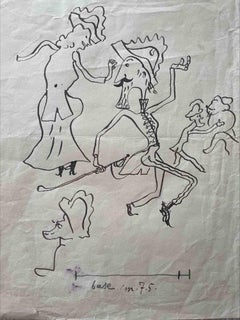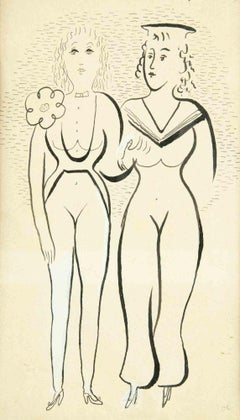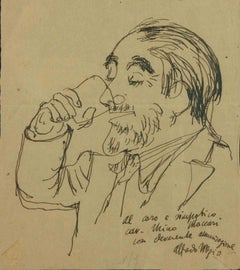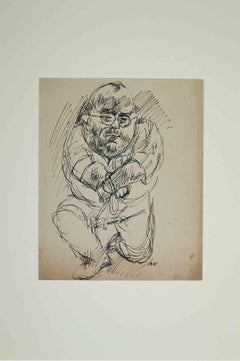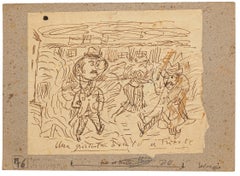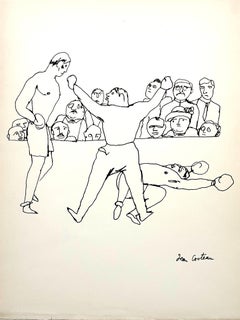Alfredo Mezio Art
to
1
7
2
4
5
2
7
Overall Height
to
Overall Width
to
5
7
6
5
4
2
2
2
2
1
1
1
1
7
4
1
7
6,856
3,181
2,516
1,217
5
2
Artist: Alfredo Mezio
Composition - Drawing by Alfredo Mezio - 1934
By Alfredo Mezio
Located in Roma, IT
Composition is a drawing in pen on paper, realized by Alfredo Mezio in 1934 for the magazine "Il Selvaggio", Year XI, p. 46.
The artwork is depicted skillfully through confident an...
Category
1930s Modern Alfredo Mezio Art
Materials
Ink
Two women - l Drawing by Mario Mafai - Early 20th Century
By Alfredo Mezio
Located in Roma, IT
Two women is an original modern artwork realized by Mario Mafai in the early 20th Century.
China ink drawings.
Some light foxings on paper.
Includes frame.
Mario Mafai Volpe (Rome, February 12, 1902 - Rome, March 31, 1965) was an Italian painter, initiator, in 1929, with Scipione and Antonietta...
Category
Early 20th Century Modern Alfredo Mezio Art
Materials
Ink
Portrait of Mino Maccari - Drawing by Alfredo Mezio - Mid-20th Century
By Alfredo Mezio
Located in Roma, IT
Portrait of Mino Maccari is an original modern artwork realized by Alfredo Mezio in the half of 20th Century.
China ink drawing.
Includes frame.
Hand signed on the lower margin
H...
Category
Mid-20th Century Modern Alfredo Mezio Art
Materials
Ink
Figure - Original Drawing by Alfredo Mezio - 1941
By Alfredo Mezio
Located in Roma, IT
Figure is an original drawing in China Ink on paper, realized by Alfredo Mezio in 1941.
The status of preservation good and aged except for some rips and a few small stains.
The a...
Category
1940s Modern Alfredo Mezio Art
Materials
Ink
Figure - Pen on Paper by Alfredo Mezio - 1930
By Alfredo Mezio
Located in Roma, IT
Figure is an original drawing in pen on paper, realized by Alfredo Mezio in 1930 ca.
Hand-signed on the lower right.
The status of preservation good and aged except for some rips a...
Category
1930s Modern Alfredo Mezio Art
Materials
Pen
One Day - Original China Ink Drawing by A. Mezio - 1938
By Alfredo Mezio
Located in Roma, IT
One Day is an original drawing in ink and pen on paper applied on cardboard, realized by Alfredo Mezio in 1938, hand-signed on cardboard, titled on lower-center of the sheet,
In goo...
Category
1930s Alfredo Mezio Art
Materials
Ink
Figure - Original Pen on Paper by Alfredo Mezio - 1930
By Alfredo Mezio
Located in Roma, IT
Figure is an original drawing in pen on paper, realized by Alfredo Mezio in 1930.
Hand-signed on the lower right.
The status of preservation good and aged except for some rips and ...
Category
1930s Alfredo Mezio Art
Materials
Pen
Related Items
The Abduction of the Sabine Women , a Renaissance drawing by Biagio Pupini
Located in PARIS, FR
This vigorous drawing has long been attributed to Polidoro da Caravaggio: The Abduction of the Sabine Women is one of the scenes that Polidoro depicted between 1525 and 1527 on the façade of the Milesi Palazzo in Rome. However, the proximity to another drawing inspired by this same façade, kept at the Ecole des Beaux-Arts, and to other drawings inspired by Polidoro kept at the Musée du Louvre, leads us to propose an attribution to Biagio Pupini, a Bolognese artist whose life remains barely known, despite the abundant number of drawings attributed to him.
1. Biagio Pupini, a Bolognese artist in the light of the Roman Renaissance
The early life of Biagio Pupini, an important figure of the first half of the Cinquecento in Bologna - Vasari mentions him several times - is still poorly known. Neither his date of birth (probably around 1490-1495) nor his training are known. He is said to have been a pupil of Francesco Francia (1450 - 1517) and his name appears for the first time in 1511 in a contract with the painter Bagnacavallo (c. 1484 - 1542) for the frescoes of a church in Faenza. He then collaborated with Girolamo da Carpi, at San Michele in Bosco and at the villa of Belriguardo.
He must have gone to Rome for the first time with Bagnacavallo between 1511 and 1519. There he discovered the art of Raphael, with whom he might have worked, and that of Polidoro da Caravaggio. This first visit, and those that followed, were the occasion for an intense study of ancient and modern art, as illustrated by his abundant graphic production.
Polidoro da Caravaggio had a particular influence on the technique adopted by Pupini. Executed on coloured paper, his drawings generally combine pen, brown ink and wash with abundant highlights of white gouache, as in the drawing presented here.
2. The Abduction of the Sabine Women
Our drawing is an adaptation of a fresco painted between 1525 and 1527 by Polidoro da Caravaggio on the façade of the Milesi Palace in Rome. These painted façades were very famous from the moment they were painted and inspired many artists during their stay in Rome. These frescoes are now very deteriorated and difficult to see, as the palace is in a rather narrow street.
The episode of the abduction of the Sabine women (which appears in the centre of the photo above) is a historical theme that goes back to the origins of Rome and is recounted both by Titus Livius (Ab Urbe condita I,13), by Ovid (Fasti III, 199-228) and by Plutarch (II, Romulus 14-19). After killing his twin brother Romus, Romulus populates the city of Rome by opening it up to refugees and brigands and finds himself with an excess of men. Because of their reputation, none of the inhabitants of the neighbouring cities want to give them their daughters in marriage. The Romans then decide to invite their Sabine neighbours to a great feast during which they slaughter the Sabines and kidnap their daughters.
The engraving made by Giovanni Battista Gallestruzzi (1618 - 1677) around 1656-1658 gives us a good understanding of the Polidoro fresco, allowing us to see how Biagio Pupini reworked the scene to extract this dynamic group.
With a remarkable economy of means, Biagio Pupini takes over the left-hand side of the fresco and depicts in a very dense space two main groups, each consisting of a Roman and a Sabine, completed by a group of three soldiers in the background (which seems to differ quite significantly from Polidoro's composition).
The balance of the drawing is based on a very strongly structured composition. The drawing is organised around a median vertical axis, which runs along both the elbow of the kidnapped Sabine on the left and the foot of her captor, and the two main diagonals, reinforced by four secondary diagonals. This diamond-shaped structure creates an extremely dynamic space, in which centripetal movements (the legs of the Sabine on the right, the arm of the soldier on the back at the top right) and centrifugal movements (the arm of the kidnapper on the left and the legs of the Sabine he is carrying away, the arm of the Sabine on the right) oppose each other, giving the drawing the appearance of a whirlpool around a central point of support situated slightly to the left of the navel of the kidnapper on the right.
3. Polidoro da Caravaggio, and the decorations of Roman palaces
Polidoro da Caravaggio was a paradoxical artist who entered Raphael's (1483 - 1520) workshop at a very young age, when he oversaw the Lodges in the Vatican. Most of his Roman work, which was the peak of his career, has disappeared, as he specialised in facade painting, and yet these paintings, which are eminently visible in urban spaces, have influenced generations of artists who copied them abundantly during their visits to Rome.
Polidoro Caldara was born in Caravaggio around 1495-1500 (the birthplace of Michelangelo Merisi, known as Caravaggio, who was born there in 1571), some forty kilometres east of Milan. According to Vasari, he arrived as a mason on the Vatican's construction site and joined Raphael's workshop around 1517 (at the age of eighteen according to Vasari). This integration would have allowed Polidoro to work not only on the frescoes of the Lodges, but also on some of the frescoes of the Chambers, as well as on the flat of Cardinal Bibiena in the Vatican.
After Raphael's death in 1520, Polidoro worked first with Perin del Vaga before joining forces with Maturino of Florence (1490 - 1528), whom he had also known in Raphael's workshop. Together they specialised in the painting of palace façades. They were to produce some forty façades decorated with grisaille paintings imitating antique bas-reliefs.
The Sack of Rome in 1527, during which his friend Maturino was killed, led Polidoro to flee first to Naples (where he had already stayed in 1523), then to Messina. It was while he was preparing his return to the peninsula that he was murdered by one of his assistants, Tonno Calabrese, in 1543.
In his Vite, Vasari celebrated Polidoro as the greatest façade decorator of his time, noting that "there is no flat, palace, garden or villa in Rome that does not contain a work by Polidoro". Polidoro's facade decorations, most of which have disappeared as they were displayed in the open air, constitute the most important lost chapter of Roman art of the Cinquecento. The few surviving drawings of the painter can, however, give an idea of the original appearance of his murals and show that he was an artist of remarkable and highly original genius.
4. The façade of the Milesi Palace
Giovanni Antonio Milesi, who commissioned this palace, located not far from the Tiber, north of Piazza Navona, was a native of the Bergamo area, like Polidoro, with whom he maintained close friendly ties. Executed in the last years before the Sack of Rome, around 1526-1527, the decoration of Palazzo Milesi is considered Polidoro's greatest decorative success.
An engraving by Ernesto Maccari made at the end of the nineteenth century allows us to understand the general balance of this façade, which was still well preserved at the time. The frescoes were not entirely monochrome, but alternated elements in chiaroscuro simulating marble bas-reliefs and those in ochre simulating bronze and gold vases...
Category
16th Century Old Masters Alfredo Mezio Art
Materials
Ink, Gouache, Pen
Jean Cocteau - The Fight - Original Signed Drawing
By Jean Cocteau
Located in Collonge Bellerive, Geneve, CH
Jean Cocteau - The Fight - Original Signed Drawing
1923
28 x 22 cm
Signed
This drawing was made as a frontispiece of the book Dessins publishe...
Category
1920s Modern Alfredo Mezio Art
Materials
Pen
Lee Hurst (3/4 Figure, Hands Together), Mixed media on Pergamenata parchment
By Howard Tangye
Located in London, GB
Howard Tangye (b.1948, Australia) has been an influential force in fashion for decades. Lecturing at London’s Central Saint Martins for 35 years, including 16 years as head of BA Wom...
Category
2010s Contemporary Alfredo Mezio Art
Materials
Paint, Paper, Parchment Paper, Charcoal, Crayon, Oil Crayon, Oil Pastel,...
Freya (Seated Backwards), Mixed media on grey board
By Howard Tangye
Located in London, GB
Howard Tangye (b.1948, Australia) has been an influential force in fashion for decades. Lecturing at London’s Central Saint Martins for 35 years, including 16 years as head of BA Wom...
Category
2010s Contemporary Alfredo Mezio Art
Materials
Other Medium, Archival Paper, Handmade Paper, Pen, Felt Pen, Permanent M...
The Sketch Class, Figurative Study Line Drawing
By David Rosen (b.1912)
Located in Soquel, CA
Expressive line drawing figure study featuring a group of figures in a classroom by David Rosen (Canadian, 1912-2004). Unsigned, but was acquire...
Category
Late 20th Century American Modern Alfredo Mezio Art
Materials
Paper, Pen, Watercolor
H 12 in W 8 in D 0.25 in
Vintage Israel Bezalel School Watercolor Painting Artist with Model Kibbutz Life
By Moshe Avni
Located in Surfside, FL
Moshe Avni was born in 1937, in Kibbutz Kfar Blum in the Upper Galilee in Israel. Presently, he lives and paints in Jerusalem. During the years 1956-1957, he studied Painting and Graphic Arts in the Bezalel Art School in Jerusalem, supported by a Betzalel School Scholarship.
He studied with and was guided by the painter Leo Roth, z”l (1914-2002), from Kibbutz Afikim.
Moshe Avni has participated in Workshops and Courses in the framework of the Kibbutz Movement and the Israeli Artists’ Organization.
He has received scholarships from both the Sharett Fund and from the Norman Fund.
In 1979, Moshe Avni was accepted to the Israeli Artists’ Organization.
Exhibitions
2011 In the Jerusalem House of Quality – 16-22 December 2011
2009 In the Neighborhood Center of Beit haKerem, Jerusalem
2003 In Moshav Batzra, Israel
1984 In the Artists’ Quarter, Rishon leZion, Israel
1979 In the House of Culture for Young People, Kfar Saba, Israel
1977 In the “New Gallery”, Tel Aviv, Israel
1973 In the “New Gallery”, Tel Aviv, Israel
1970 In “The House of Uri and Rami Nechushtan” in Ashdot Yaacov, Israel
Horses & People, New Gallery, Tel Aviv
1965 Journalists House - Sokolov House, Tel Aviv, Israel
Exhibitions of Young Artists in “House of Helena Rubenstein”, Tel Aviv, Israel
Private Exhibitions in Jerusalem, Tel Aviv, and more.
Group Exhibitions
Kiryat Shmona 1957
Artists: Noemi Schindler...
Category
1960s Modern Alfredo Mezio Art
Materials
Pen, Watercolor
"Flower Stand S.F. 1954" - Vintage Illustration
By Irene Pattinson
Located in Soquel, CA
"Flower Stand S.F. 1954" - Vintage Illustration
This detailed ink drawing by Irene Pattinson (American, 1909-1999), shows a charming San Francisc...
Category
1950s American Modern Alfredo Mezio Art
Materials
Paper, India Ink, Pen
Cats Watching a Witch on a Broomstick - Vintage Halloween Illustration in Ink
By Irene Pattinson
Located in Soquel, CA
Cats Watching a Witch on a Broomstick - Vintage Halloween Illustration in Ink
Halloween scene with cats and a witch in India ink pen by Irene Pattinson (American, 1909-1999). A blac...
Category
1950s American Modern Alfredo Mezio Art
Materials
Paper, Watercolor, Pen, India Ink
H 18 in W 20 in D 0.25 in
Untitled, Mixed Media on Paper, Black, Yellow colour by Modern Artist "In Stock"
By Sakti Burman
Located in Kolkata, West Bengal
Sakti Burman
(a) Untitled - 3 x 6 inches (Unframed size)
Pen on Paper , 1992
(b) Untitled - 4.5 x 9 inches (Unframed size)
Mixed Media on Paper , 1992
Framed & Door Deliver...
Category
21st Century and Contemporary Modern Alfredo Mezio Art
Materials
Ink, Paper, Mixed Media, Pen
Harlequin instrument juggler - Drawing
Located in Geneva, CH
Work on paper
Golden wooden frame with glass pane
51 x 43,5 x 2,5 cm
Illegible signature
Category
Late 20th Century Modern Alfredo Mezio Art
Materials
Pen, Pencil
Akt mit Strümpfen
By August Wilhelm Dressler
Located in Wien, 9
August Dressler is one of the painters of the New Objectivity. He is one of the lesser-known artists of the Weimar era, but he too, like his famous contemporaries Georg Grosz, John H...
Category
1920s Modern Alfredo Mezio Art
Materials
Watercolor, Ink
1950s "Upclose Portrait" Mid Century Ink Portrait Drawing Pratt
By Donald Stacy
Located in Arp, TX
Donald Stacy (1925-2008) New Jersey
"Upclose Portrait"
1953
Ink on paper
14" x 16.5" unframed
Signed and dated in pencil lower right
Came from artist estate
*Custom framing available...
Category
Mid-20th Century American Modern Alfredo Mezio Art
Materials
Paper, Ink
Alfredo Mezio art for sale on 1stDibs.
Find a wide variety of authentic Alfredo Mezio art available for sale on 1stDibs. You can also browse by medium to find art by Alfredo Mezio in ink, pen and more. Much of the original work by this artist or collective was created during the 20th century and is mostly associated with the modern style. Not every interior allows for large Alfredo Mezio art, so small editions measuring 5 inches across are available. Customers who are interested in this artist might also find the work of Emil Ganso, Manfredo Borsi, and Gio Colucci. Alfredo Mezio art prices can differ depending upon medium, time period and other attributes. On 1stDibs, the price for these items starts at $668 and tops out at $4,233, while the average work can sell for $741.
